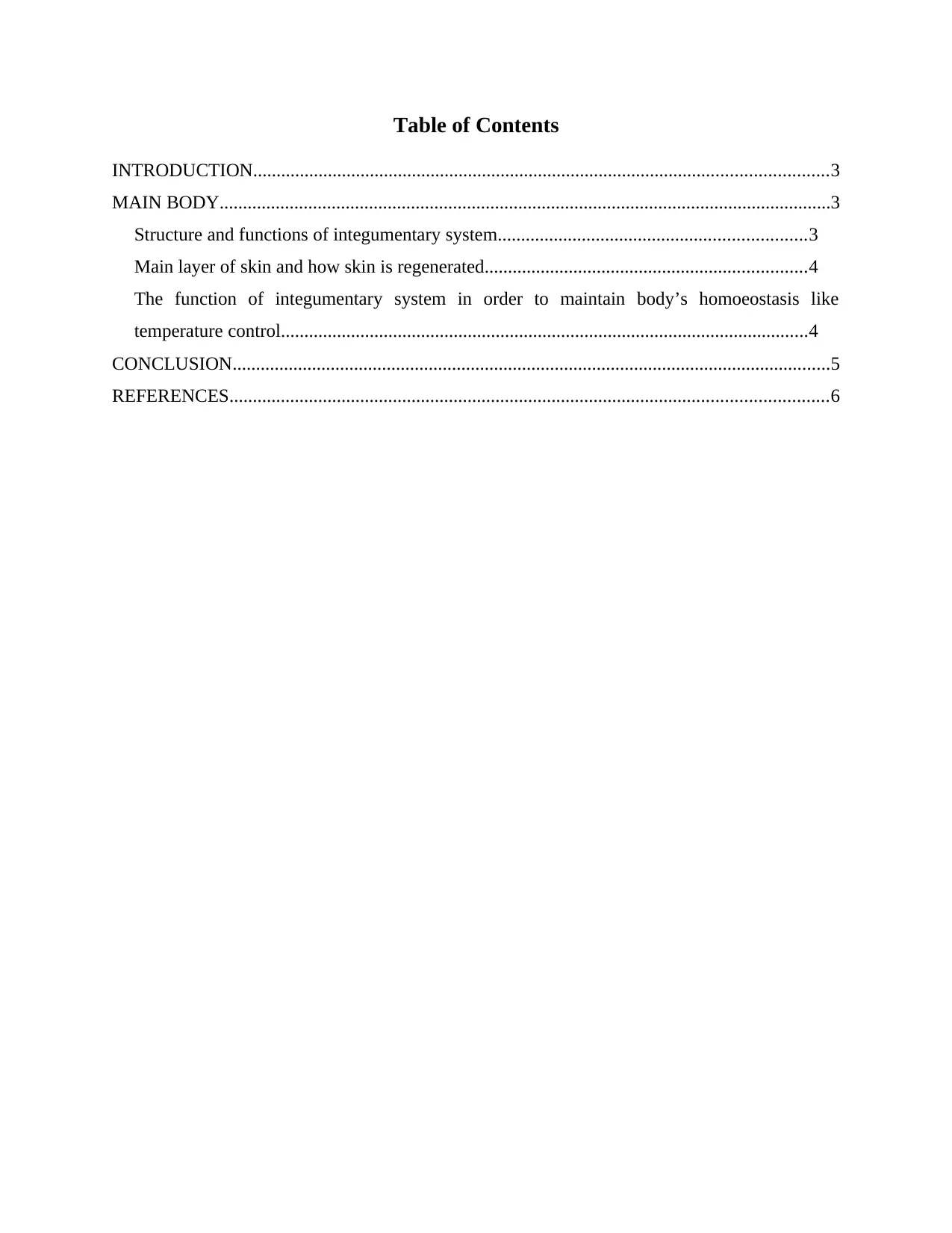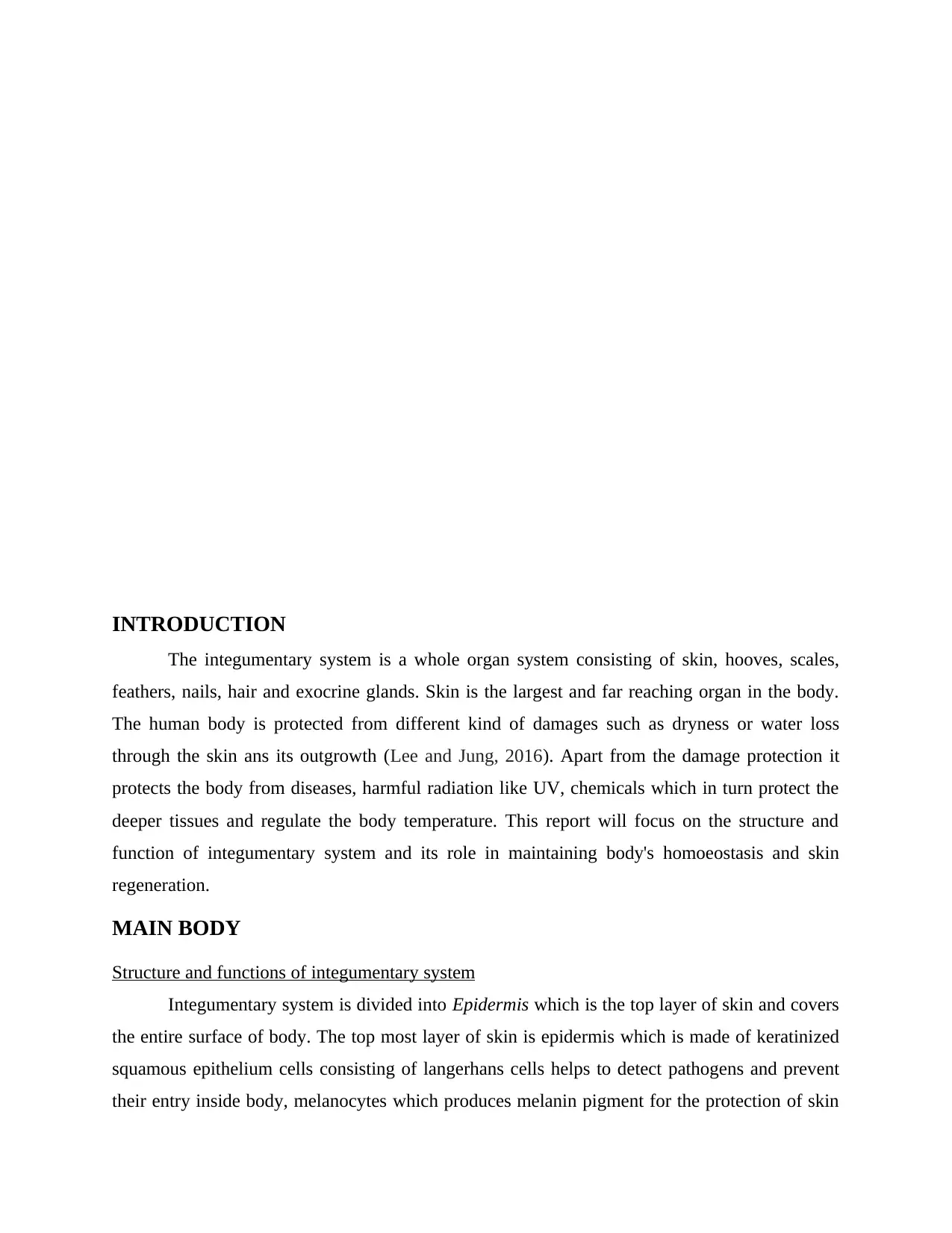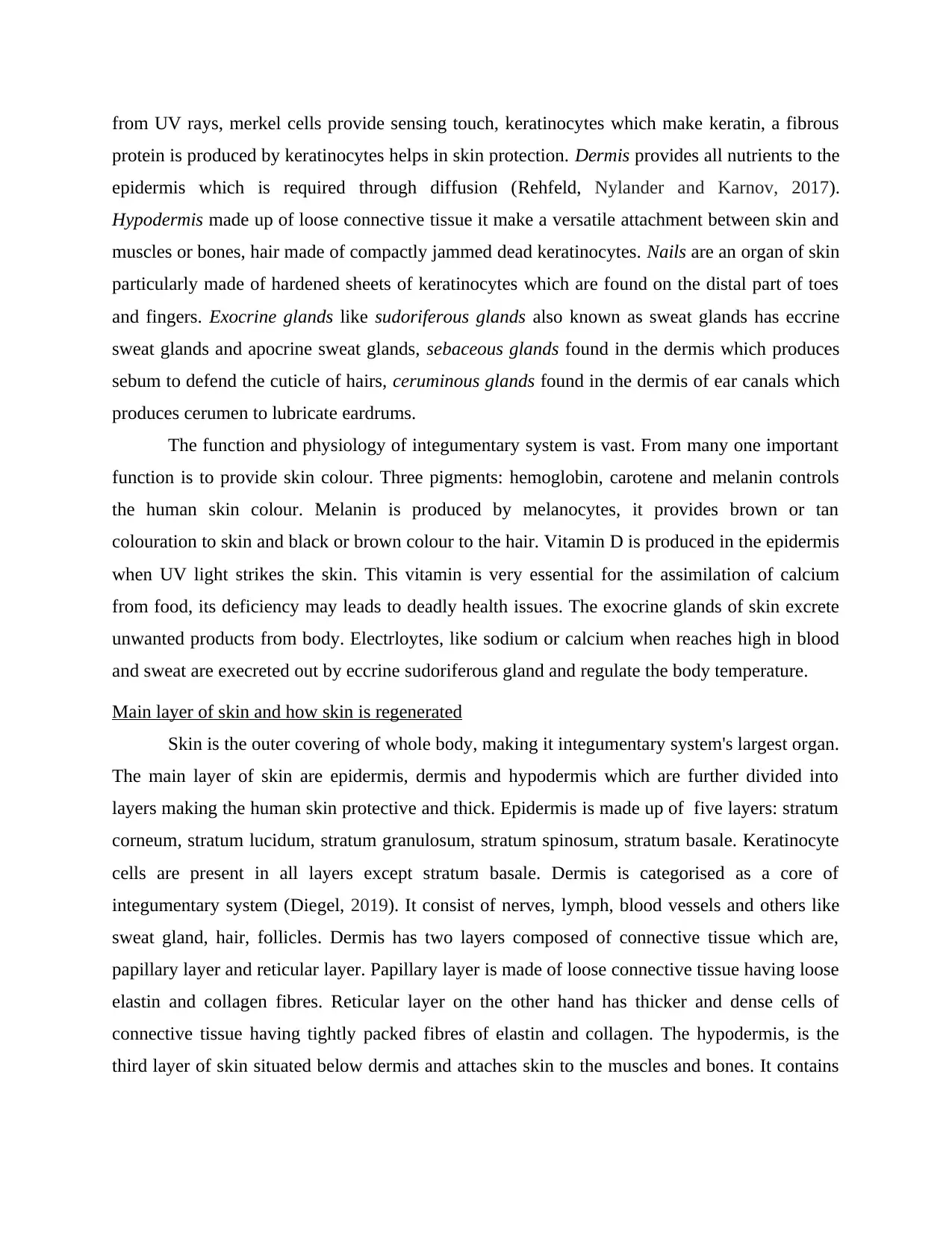Structures and Functions of the Integumentary System
VerifiedAdded on 2023/01/19
|7
|1452
|28
AI Summary
This article explores the structure and functions of the integumentary system, focusing on the skin, hooves, scales, feathers, nails, hair, and exocrine glands. It discusses the role of the integumentary system in maintaining body's homoeostasis, including temperature control and skin regeneration.
Contribute Materials
Your contribution can guide someone’s learning journey. Share your
documents today.

The Structures And Functions Of
The Integumentary System
The Integumentary System
Secure Best Marks with AI Grader
Need help grading? Try our AI Grader for instant feedback on your assignments.

Table of Contents
INTRODUCTION...........................................................................................................................3
MAIN BODY...................................................................................................................................3
Structure and functions of integumentary system..................................................................3
Main layer of skin and how skin is regenerated.....................................................................4
The function of integumentary system in order to maintain body’s homoeostasis like
temperature control.................................................................................................................4
CONCLUSION................................................................................................................................5
REFERENCES................................................................................................................................6
INTRODUCTION...........................................................................................................................3
MAIN BODY...................................................................................................................................3
Structure and functions of integumentary system..................................................................3
Main layer of skin and how skin is regenerated.....................................................................4
The function of integumentary system in order to maintain body’s homoeostasis like
temperature control.................................................................................................................4
CONCLUSION................................................................................................................................5
REFERENCES................................................................................................................................6

INTRODUCTION
The integumentary system is a whole organ system consisting of skin, hooves, scales,
feathers, nails, hair and exocrine glands. Skin is the largest and far reaching organ in the body.
The human body is protected from different kind of damages such as dryness or water loss
through the skin ans its outgrowth (Lee and Jung, 2016). Apart from the damage protection it
protects the body from diseases, harmful radiation like UV, chemicals which in turn protect the
deeper tissues and regulate the body temperature. This report will focus on the structure and
function of integumentary system and its role in maintaining body's homoeostasis and skin
regeneration.
MAIN BODY
Structure and functions of integumentary system
Integumentary system is divided into Epidermis which is the top layer of skin and covers
the entire surface of body. The top most layer of skin is epidermis which is made of keratinized
squamous epithelium cells consisting of langerhans cells helps to detect pathogens and prevent
their entry inside body, melanocytes which produces melanin pigment for the protection of skin
The integumentary system is a whole organ system consisting of skin, hooves, scales,
feathers, nails, hair and exocrine glands. Skin is the largest and far reaching organ in the body.
The human body is protected from different kind of damages such as dryness or water loss
through the skin ans its outgrowth (Lee and Jung, 2016). Apart from the damage protection it
protects the body from diseases, harmful radiation like UV, chemicals which in turn protect the
deeper tissues and regulate the body temperature. This report will focus on the structure and
function of integumentary system and its role in maintaining body's homoeostasis and skin
regeneration.
MAIN BODY
Structure and functions of integumentary system
Integumentary system is divided into Epidermis which is the top layer of skin and covers
the entire surface of body. The top most layer of skin is epidermis which is made of keratinized
squamous epithelium cells consisting of langerhans cells helps to detect pathogens and prevent
their entry inside body, melanocytes which produces melanin pigment for the protection of skin

from UV rays, merkel cells provide sensing touch, keratinocytes which make keratin, a fibrous
protein is produced by keratinocytes helps in skin protection. Dermis provides all nutrients to the
epidermis which is required through diffusion (Rehfeld, Nylander and Karnov, 2017).
Hypodermis made up of loose connective tissue it make a versatile attachment between skin and
muscles or bones, hair made of compactly jammed dead keratinocytes. Nails are an organ of skin
particularly made of hardened sheets of keratinocytes which are found on the distal part of toes
and fingers. Exocrine glands like sudoriferous glands also known as sweat glands has eccrine
sweat glands and apocrine sweat glands, sebaceous glands found in the dermis which produces
sebum to defend the cuticle of hairs, ceruminous glands found in the dermis of ear canals which
produces cerumen to lubricate eardrums.
The function and physiology of integumentary system is vast. From many one important
function is to provide skin colour. Three pigments: hemoglobin, carotene and melanin controls
the human skin colour. Melanin is produced by melanocytes, it provides brown or tan
colouration to skin and black or brown colour to the hair. Vitamin D is produced in the epidermis
when UV light strikes the skin. This vitamin is very essential for the assimilation of calcium
from food, its deficiency may leads to deadly health issues. The exocrine glands of skin excrete
unwanted products from body. Electrloytes, like sodium or calcium when reaches high in blood
and sweat are execreted out by eccrine sudoriferous gland and regulate the body temperature.
Main layer of skin and how skin is regenerated
Skin is the outer covering of whole body, making it integumentary system's largest organ.
The main layer of skin are epidermis, dermis and hypodermis which are further divided into
layers making the human skin protective and thick. Epidermis is made up of five layers: stratum
corneum, stratum lucidum, stratum granulosum, stratum spinosum, stratum basale. Keratinocyte
cells are present in all layers except stratum basale. Dermis is categorised as a core of
integumentary system (Diegel, 2019). It consist of nerves, lymph, blood vessels and others like
sweat gland, hair, follicles. Dermis has two layers composed of connective tissue which are,
papillary layer and reticular layer. Papillary layer is made of loose connective tissue having loose
elastin and collagen fibres. Reticular layer on the other hand has thicker and dense cells of
connective tissue having tightly packed fibres of elastin and collagen. The hypodermis, is the
third layer of skin situated below dermis and attaches skin to the muscles and bones. It contains
protein is produced by keratinocytes helps in skin protection. Dermis provides all nutrients to the
epidermis which is required through diffusion (Rehfeld, Nylander and Karnov, 2017).
Hypodermis made up of loose connective tissue it make a versatile attachment between skin and
muscles or bones, hair made of compactly jammed dead keratinocytes. Nails are an organ of skin
particularly made of hardened sheets of keratinocytes which are found on the distal part of toes
and fingers. Exocrine glands like sudoriferous glands also known as sweat glands has eccrine
sweat glands and apocrine sweat glands, sebaceous glands found in the dermis which produces
sebum to defend the cuticle of hairs, ceruminous glands found in the dermis of ear canals which
produces cerumen to lubricate eardrums.
The function and physiology of integumentary system is vast. From many one important
function is to provide skin colour. Three pigments: hemoglobin, carotene and melanin controls
the human skin colour. Melanin is produced by melanocytes, it provides brown or tan
colouration to skin and black or brown colour to the hair. Vitamin D is produced in the epidermis
when UV light strikes the skin. This vitamin is very essential for the assimilation of calcium
from food, its deficiency may leads to deadly health issues. The exocrine glands of skin excrete
unwanted products from body. Electrloytes, like sodium or calcium when reaches high in blood
and sweat are execreted out by eccrine sudoriferous gland and regulate the body temperature.
Main layer of skin and how skin is regenerated
Skin is the outer covering of whole body, making it integumentary system's largest organ.
The main layer of skin are epidermis, dermis and hypodermis which are further divided into
layers making the human skin protective and thick. Epidermis is made up of five layers: stratum
corneum, stratum lucidum, stratum granulosum, stratum spinosum, stratum basale. Keratinocyte
cells are present in all layers except stratum basale. Dermis is categorised as a core of
integumentary system (Diegel, 2019). It consist of nerves, lymph, blood vessels and others like
sweat gland, hair, follicles. Dermis has two layers composed of connective tissue which are,
papillary layer and reticular layer. Papillary layer is made of loose connective tissue having loose
elastin and collagen fibres. Reticular layer on the other hand has thicker and dense cells of
connective tissue having tightly packed fibres of elastin and collagen. The hypodermis, is the
third layer of skin situated below dermis and attaches skin to the muscles and bones. It contains
Paraphrase This Document
Need a fresh take? Get an instant paraphrase of this document with our AI Paraphraser

loose but well vascularized connective and adipose tissue, which serves as mode of storing fats
and maintain insulation of integument.
Each and every layer of skin like epidermis, dermis and hypodermis are capable of
undergoing regeneration when the integrity of skin has disrupted. Epidermis repair starts within
stratum basale. Regeneration first stage involves division of stratum basale cells. Once divided,
they migrate upwards to epidermis to fill up the space (Gilaberte and et. al., 2016). Injuries that
perforate into dermis are regenerated by secreting fibres like elastin and collagen, which are
moving cells, so they move from the source of regeneration to the edges of cut or wound.
The function of integumentary system in order to maintain body’s homoeostasis like temperature
control
Integumentary system is a combination or set of organs which consist of skin, hair, glands, nails
and nerves. The role of integumentary system is to protect body from external factors. The
system plays a great role in maintain body's homoeostasis which is essential for body to work
efficiently. Hence, the ability to maintain a constant and stable internal environment is called
homoeostasis. Our skin performs variety of functions in developing constant temperature
including protection, regulating body temperature, balancing water levels, synthesising vitamins
and hormones and intake of minerals.
The integumentary system have a tendency of thermoregulation and keeps body
temperature within secured boundaries even when external environment is fluctuating. Skin
reacts differently to hot and cold conditions to maintain internal environment of body. In order to
cool down, skin starts expanding its blood vessels which results in cooling the body temperature
because expanded vessels of skin allows a larger amount of blood flow which help in vanishing
body heat through radiation (Diegel, Danilenko and Wojcinsk, 2018). Our body also looses heat
through the process of sweating. Body starts sweating when its temperature rises above 37 °C.
Sweat production increase when body requires to cool down. It takes body heat away by
formation of droplets on skin surface and then evaporates. To keep internal environment warm,
skin starts constricting blood vessels so that less amount of heat could escape in the environment.
The body will limit its production of sweating to minimize heat loss. Due to contraction of
arrector pili muscles, hair follicles lift in upward direction. This cause hair to stand and work as a
protective layer in trapping heat.
and maintain insulation of integument.
Each and every layer of skin like epidermis, dermis and hypodermis are capable of
undergoing regeneration when the integrity of skin has disrupted. Epidermis repair starts within
stratum basale. Regeneration first stage involves division of stratum basale cells. Once divided,
they migrate upwards to epidermis to fill up the space (Gilaberte and et. al., 2016). Injuries that
perforate into dermis are regenerated by secreting fibres like elastin and collagen, which are
moving cells, so they move from the source of regeneration to the edges of cut or wound.
The function of integumentary system in order to maintain body’s homoeostasis like temperature
control
Integumentary system is a combination or set of organs which consist of skin, hair, glands, nails
and nerves. The role of integumentary system is to protect body from external factors. The
system plays a great role in maintain body's homoeostasis which is essential for body to work
efficiently. Hence, the ability to maintain a constant and stable internal environment is called
homoeostasis. Our skin performs variety of functions in developing constant temperature
including protection, regulating body temperature, balancing water levels, synthesising vitamins
and hormones and intake of minerals.
The integumentary system have a tendency of thermoregulation and keeps body
temperature within secured boundaries even when external environment is fluctuating. Skin
reacts differently to hot and cold conditions to maintain internal environment of body. In order to
cool down, skin starts expanding its blood vessels which results in cooling the body temperature
because expanded vessels of skin allows a larger amount of blood flow which help in vanishing
body heat through radiation (Diegel, Danilenko and Wojcinsk, 2018). Our body also looses heat
through the process of sweating. Body starts sweating when its temperature rises above 37 °C.
Sweat production increase when body requires to cool down. It takes body heat away by
formation of droplets on skin surface and then evaporates. To keep internal environment warm,
skin starts constricting blood vessels so that less amount of heat could escape in the environment.
The body will limit its production of sweating to minimize heat loss. Due to contraction of
arrector pili muscles, hair follicles lift in upward direction. This cause hair to stand and work as a
protective layer in trapping heat.

CONCLUSION
From above study, it can be concluded that Integumentary system plays a great role in
developing body's homoeostasis. It consists of skin, hair, nerves and nails and helps in protecting
the body from external factors. Skin reacts to different environmental conditions accordingly to
maintain inner temperament. It performs different functions in order to make internal
environment stable so that body could work in an efficient manner. It includes some roles such
as protection, regulating body temperature, balancing water levels, synthesising vitamins and
hormones and intake of minerals.
From above study, it can be concluded that Integumentary system plays a great role in
developing body's homoeostasis. It consists of skin, hair, nerves and nails and helps in protecting
the body from external factors. Skin reacts to different environmental conditions accordingly to
maintain inner temperament. It performs different functions in order to make internal
environment stable so that body could work in an efficient manner. It includes some roles such
as protection, regulating body temperature, balancing water levels, synthesising vitamins and
hormones and intake of minerals.

REFERENCES
Books and journals
Lee, K. C., & Jung, D. I. (2016). An Outline of the Integumentary System. In Integumentary
Physical Therapy(pp. 1-42). Springer, Berlin, Heidelberg.
Rehfeld, A., Nylander, M., & Karnov, K. (2017). The Integumentary System. In Compendium of
Histology (pp. 411-432). Springer, Cham.
Diegel, K. L. (2019). Pathology of the Integumentary System. In Toxicologic Pathology for Non-
Pathologists (pp. 483-535). Humana, New York, NY.
Gilaberte, Y. & et. al., (2016). Anatomy and Function of the Skin. In Nanoscience in
Dermatology (pp. 1-14). Academic Press.
Diegel, K. L., Danilenko, D. M., & Wojcinski, Z. W. (2018). The Integumentary System.
In Fundamentals of Toxicologic Pathology (pp. 791-822). Academic Press.
Books and journals
Lee, K. C., & Jung, D. I. (2016). An Outline of the Integumentary System. In Integumentary
Physical Therapy(pp. 1-42). Springer, Berlin, Heidelberg.
Rehfeld, A., Nylander, M., & Karnov, K. (2017). The Integumentary System. In Compendium of
Histology (pp. 411-432). Springer, Cham.
Diegel, K. L. (2019). Pathology of the Integumentary System. In Toxicologic Pathology for Non-
Pathologists (pp. 483-535). Humana, New York, NY.
Gilaberte, Y. & et. al., (2016). Anatomy and Function of the Skin. In Nanoscience in
Dermatology (pp. 1-14). Academic Press.
Diegel, K. L., Danilenko, D. M., & Wojcinski, Z. W. (2018). The Integumentary System.
In Fundamentals of Toxicologic Pathology (pp. 791-822). Academic Press.
1 out of 7
![[object Object]](/_next/static/media/star-bottom.7253800d.svg)





